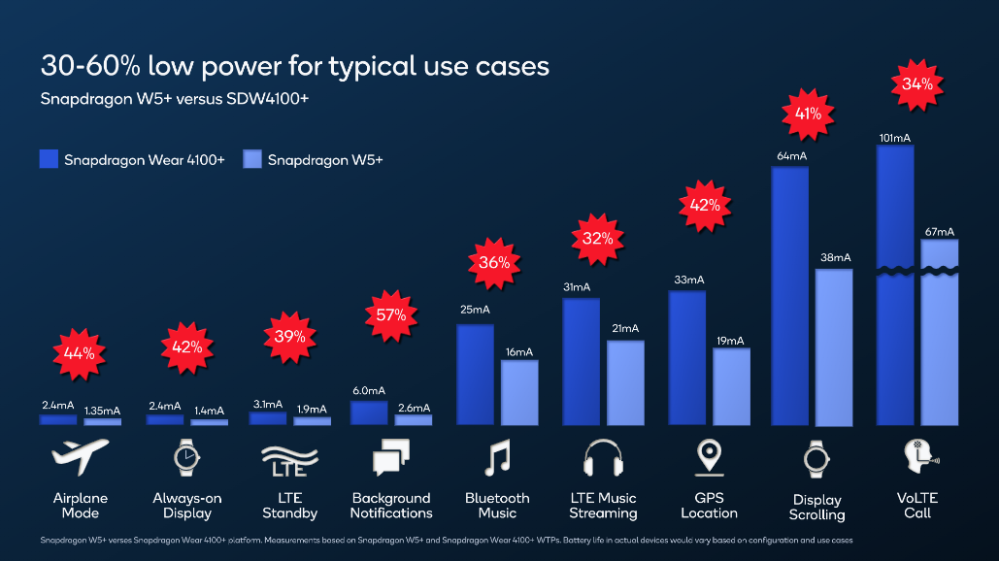
The Snapdragon W5+ Gen 1 is a huge leap forward for Wear OS smartwatches in terms of both performance and efficiency, and Qualcomm is making huge claims for battery life.
Snapdragon W5+ Gen 1 is built on top of a 4nm process, making it a far more efficient chipset compared to what Qualcomm has been using for the past several years. For reference, the Snapdragon Wear 2100 and 3100 both ran on a 28nm process, while the Snapdragon Wear 4100 used a 12nm process.
With that, Qualcomm says that Snapdragon W5+ Gen 1 has power reductions of 30-60% for “key use cases” compared to the Snapdragon Wear 4100+. The biggest area of improvement seems to be in background notifications, which see a 57% reduction in power usage, but the biggest area of active battery drain is VoLTE calls, which should eat up around 34% less power on the new chip.
Qualcomm breaks down the power savings as you can see below.

How does that translate to actual battery life? Qualcomm has some ambitious stats to share.
Snapdragon W5+ Gen 1 battery life estimates
First, Qualcomm shares an example of a “sleek fashionable” smartwatch that has a 300 mAh battery. If that device managed 28 hours with the Snapdragon Wear 4100+, it would hit 43 hours on the Snapdragon W5+ Gen 1.
That 300 mAh total is key to the story here, as it’s roughly the average we see on most smartwatches. The Fossil Gen 6, for example, is rated for 24 hours of battery life with its 300 mAh battery. By Qualcomm’s stats, that device would see at least 40 hours of battery life on the Snapdragon W5+ Gen 1.
And really, that does line up with what we’d expect from the move to a 4nm processor.
The Galaxy Watch 4 is rated for 40 hours of battery life on its 5nm Exynos chip, so Qualcomm’s estimate here is not at all out of the question.
Moving up to a “4G Connected Smartwatch” with a 450 mAh battery, Qualcomm claims over two days of battery life. If that smartwatch got 36 hours of battery life on the Snapdragon Wear 4100+, it would see 54 hours on the W5+.
Finally, Qualcomm shares an example of a “4G Connected Sportswatch” with a 600 mAh battery. Where that would get 48 hours of battery life on a 4100+, Qualcomm says it would get 72 hours on a Snapdragon W5+ Gen 1. It’s extremely important to note when look at that figure, though, that there’s not a single Wear OS smartwatch on the market currently with a capacity that large.

The only smartwatch we know of that would get close is the Galaxy Watch 5 Pro, which hasn’t been released just yet but is expected to ship with a 572 mAh battery. Looking back at Wear OS’ history, the Polar M600 had a 500 mAh battery and quoted two days of battery life, including eight hours of workout tracking. The more recent Suunto 7 probably has a similarly sized battery, but we couldn’t find anywhere that Suunto discloses the actual size of the battery, just that it gets two days of use under “normal” conditions.
9to5Google’s Take
Needless to say, this is huge if it’s true.
Having the average Wear OS smartwatch last over 40 hours on a charge would solve the complaints of most folks, and put smartwatches on Google’s platform in the same ballpark, at least in the realm of battery life, as the Apple Watch. This also opens the door to much smaller Wear OS smartwatches that may sacrifice room for a full-sized battery, but still remain usable for a full day.
Of course, it’s hard to take things at face value, and even Qualcomm knows these estimates may not pan out.
Qualcomm says that it came up with these estimates based on “internal measurements and projections,” so you should definitely expect actual Wear OS products using the Snapdragon W5+ Gen 1 to vary considerably in actual battery life.
Still, if what Qualcomm is saying is any indication, battery woes on Wear OS might finally be coming to an end. At least, for those of us reasonable enough to admit that a full-featured smartwatch doesn’t need to last a week on a charge.
More on Wear OS:
- Montblanc offers a good look at Wear OS 3 without Samsung’s skin
- Fossil working on companion app for its Wear OS 3 watches
- Wear OS 3 will still work with iPhone, despite Galaxy Watch 4 stripping support
FTC: We use income earning auto affiliate links. More.




Comments